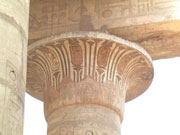TOUR NEWS - GILF KEBIR CAMPING TRIP LATE FEBRUARY 2009
Nine members on the Oasis tour group took part in a 9 day camping trip to explore the landscapes and Neolithic rock-art of the Gilf Kebir. They included: Kate Gosford, Brenda Wass, John Burke, Shyam Lee-Joe, Peter and Erica Wallace, Warwick Barnard and Carol Rowe, and Michael Birrell. We were joined by Hungarian rock-art expert Andras Zboray (who has been collecting a photographic record of the ancient remains in the area for more than 10 years) and his Egyptian tour co-ordinator Khaled. The group travelled by 4-wheel drive vehicles and we camped at a number of different locations as we explored the region. The remoteness of the region can be gauged by the fact that we travelled about 2500 km, from Kharga Oasis into the remote desert and back to Dakhleh Oasis, over a period of 10 days, and never saw another person or vehicle until we came back onto the sealed road. The journey was unlike anything previously experienced by the author and was full of the most fantastic landscapes and beautiful rock art - it is hard to convey the experience in mere words and pictures!
Our first day of the trip began on the 20th February. We made an early start but were slowed down while we waited the allocation of our security person - he spent the rest of the trip convinced that he was in charge of the expedition, despite the fact that he didn't have the faintest idea where we were going! We drove south from Kharga City down the asphalt road following the old slave caravan trail of the Darb el Arbain (the '40 Day track'). En route we collected some fire wood from along the road side and near isolated farmsteads - this would last us for the first few days. The landscape was remarkably desolate - once we left the sealed road we started across the remarkably flat Selima Sand Sheet, which stretched far to the west. Only small isolated mounds of granite occasionally appeared. We stopped to camp for the night at the small oasis of Bir Terfawi - a few palm trees surrounded by the desolation but rich in birdlife. The night sky was spectacular.
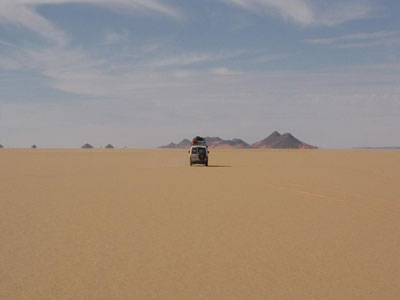 |
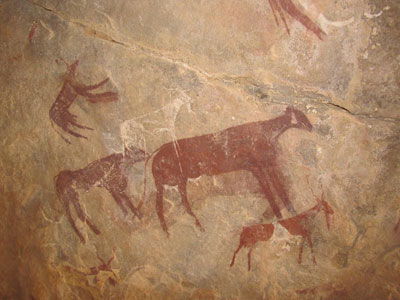 |
The Selima Sand Sheet west of Bir Terfawi |
Neolithic rock art south of the Gilf Kebir |
The following morning we continued our journey towards the south west, stopping for a while at the Abu Hussein Dunes. These monumental barkhan dunes creep slowly across the flat sand field. In the afternoon we had our first sighting of the Gilf Kebir plateau - enormous 300 m high cliffs rising precipitously from the open desert. The huge tableland covers 7000 square km and is slowly being eroded by the action of wind and rain, leaving deep valleys and spectacular rock formations. We soon arrived at the WWII aerodrome at "8 Bells", named after the small desert hills in the area. From here we advanced into the Gilf via the Wadi Firaq to visit our first rock art site: 'Shaw's cave'. This Neolithic site is decorated with red and white cattle and had a superb view south into a warren of valleys. We then headed south to the edge of the Gilf plateau and thence into the open desert near the Sudanese border. The landscape was marked by ethereal granite outcroppings which glowed red in the afternoon sun - here we set up camp and enjoyed an even more spectacular night sky than the previous one. The nearest house was probably 300 km away in Libya and there was not a blade of grass to be seen anywhere - just sand and rocks!
The next day we headed further south to explore a number of rock-art sites in the area. These included very depictions of very early Uweinat 'round head' art scenes possibly 9,000 years old. The most spectacular rock art was a more recent cave covered with superb scenes of cattle and 'homesteads', small camps with family groups. The bareness of the area was an indication of how much the climate and local landscape has changed since Neolithic times when this part of the Sahara was a fertile savannah.
In the afternoon we drove north along the western edge of the Gilf Kebir plateau via 'three castles' to the stunning Wadi Sora 'Painted Valley'. In the dark we walked across the spectacular valley floor to see the fascinating 'Cave of Swimmers', made famous by the movie 'The English Patient'. The small scale figures include mysterious figures that appear to be swimming across the rock surface, often found in association with strange headless beasts who appear to be attacking the various human figures. The following day was spent in the Wadi Sora area, visiting recently discovered new rock art sites, including the magnificent West Gilf 21 site. This ranks among the most important Saharan rock art discoveries for several decades and consists of a huge rock wall covered with hundreds of human and animal figures including numerous 'swimmers' and headless beasts.
In the afternoon we explored a number of smaller sites and then had a scenic trek for about 4 km back to our campsite. We passed through the most fantastic desert valleys, stopping to look at small rock-art sites but mostly enjoying the vastness and solitude of this place. In the evening we experienced our first sand storm - this swept in off the Libyan Desert and gave everyone the feeling that their tent was going to be swept away - an experience of the vast and unpredictable forces of the Sahara!
 |
 |
The Gilf Kebir group explores West Gilf 21 rock shelter |
Exploring Wadi Sora |
From Wadi Sora we drove south along the edge of the Gilf Kebir plateau and then made our ascent of the Aqaba Pass which leads up onto the summit of the plateau. It was here that we saw our first sparse plants, the result of a rare downpour last year. We passed through the central Gilf valley known as 'The Gap', with its enormous sand drifts and towering cliffs. The cars took a few attempts to reach the summit of the plateau, where we had a superb view over the desolation. The sight of the Libyan Desert from the 300 m high cliff top was stunning. In the empty landscape we came upon the remarkable sight of desert melons growing near the track. Later in the day we descended into the east branch of Wadi Abd el Melik via the Lama Pass, a sand choked valley giving access to this huge desert valley. We pitched camp in a surreal isolated desert valley - huge acacia trees which had thrived in the 19th Century had all died about 50 years ago and their dried husks gave a fantastical sense of desolation and decay.
The next day we explored more of the Wadi Abd el Melik, taking a walk up the valley in search of a well which had been located by Count Laslo Almasy (the 'English Patient') in the 1930s. We found evidence of Barbary sheep, which clearly still found sustenance in the area, and were buzzed by enormous dragonflies. Later in the day we explored some isolated rock art in the nearby Wadi Talh 'Acacia Valley' and saw a Neolithic tomb mound. We then made the decision to drive to our camp site in the Wadi Hamra, thus enabling us to have 2 nights in the one place. This entailed making a crossing of the desert plateau and a long drive to the end of the Wadi Hamra. Our campsite was not reached until after dark, which caused our security official some angst, but the effort was worth it. The Wadi Hamra, the 'Red Valley', was a superb desert vale with bright red sand. Last years rain had resulted in spectacular new growth up the entire valley, giving one the sense of paradise in the wilderness.
We woke to a spectacular scene of the red desert and took our time to enjoy the nearby oasis gardens. Many trees and bushes were in flower and flocks of small birds were winging overhead in search of insects. I felt as if we had discovered the mythological Zerzura, the 'Oasis of Little Birds'. We spent the rest of the day exploring the rock art in the upper reaches of the valley and saw numerous lizards and birds. In the evening, however, we experienced our second sandstorm which seemed fiercer than the first one. Our desert paradise had quickly revealed its wild side and we all felt our tents were going to fly off towards Libya!
The following day, the 27th February, we began to make our way back towards the Nile Valley. In the morning we headed north out of the Wadi Hamra and began the crossing of the dune belt filling the 'Gap'. The landscape was fantastical with huge dunes disappearing into the distance, and the dark brooding sky gave the landscape an otherworldly aspect. The crossing of the dune belt took less time than expected and soon we were heading across the open desert. We stopped to survey 'Bagnold's stone circle', a Neolithic structure to the east of the Gilf Kebir. We pitched our tents in a sheltered spot overlooking a vast desert plane near a belt of long Seif dunes.
The next day we continued east till we got to the 'Hill with stone circles'. This is an amazingly picturesque paleo-lake with enormous pink yardangs known as 'The Red Lions', wind carved formations of mud left over from a prehistoric lake where ancient people had built hut shelters. Scattered on the surface were the remains of their stone tools, some made of 'Libyan Glass', a rare mineral found in the area. From here we headed NE and camped near a small desert plateau known as Abu Ballas 'Pottery Hill'. This has always been a stopping point since ancient trade caravans and raiders used it and still preserves the remains of some of the pottery which they had discarded.
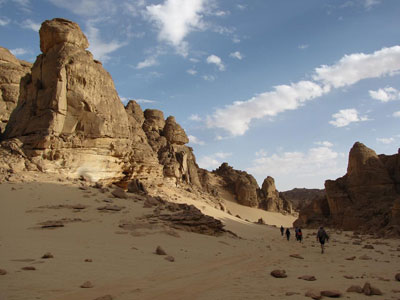 |
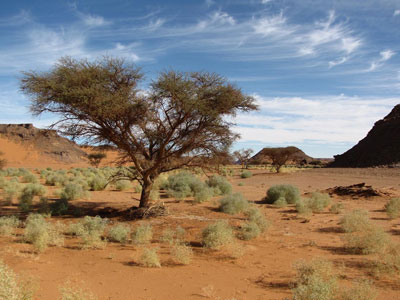 |
Exploring the canyons of the western Gilf Kebir |
The oasis blooms: Wadi Hamra |
This was our last night in the open desert and it was with some regret that we headed back towards civilization. Our trip took us across the open desert until we came to the asphalt road leading from Bir Terfawi to Dakhleh. After those many days alone in the world, it felt strange and somehow foreign to see trucks and cars, and to hear other human voices. Our way led north to Dakhleh Oasis and the noisy and chaotic life in the town. After lunch we headed to Kharga Oasis and were very pleased to have a hot shower and a drink in the bar of our hotel after all these days out in the wilderness. Although we had only been away for 10 days if felt as if we had been somewhere distant and alien, and had experienced a surreal landscape which very few people on earth have seen. Our journey to Luxor the following day only re-enforced the wonderful sense of quiet and isolation which we had enjoyed.
Michael Birrell
